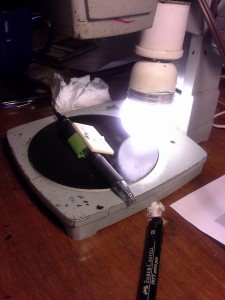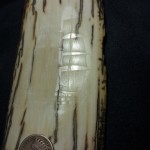
A free-arm microscope and a Brady Block are two tools I’d love to incorporate into my scrimshaw tool set (along with my very own studio), but cost prohibits me from adding these at the moment. As related in a previous post, the Brady block allows you to turn and angle your material quickly and easily, and a free arm microscope gives you the room to put it underneath. As I’m working with a low-power inspection microscope, my area is limited, as is the angle of the light to the material.
Using a small loose roll of masking tape and a pen, I can angle the material its polished surface reflects my light source, making the scribe lines and stipples much easier to see.
- Make a small roll of masking tape with the sticky side out slightly larger than your finger,
- Place a pen inside and place it on your microscope table or work surface,
- Set your work so you can see it through the microscope and angle it so you see the light source reflected on the material’s surface.
Jason Webb’s photos of his works in progress shows this contrast well. This should also work for anyone using an optivisor. Another option is to stick your material onto a small hard surface and place a bean bag underneath to prop it up.
